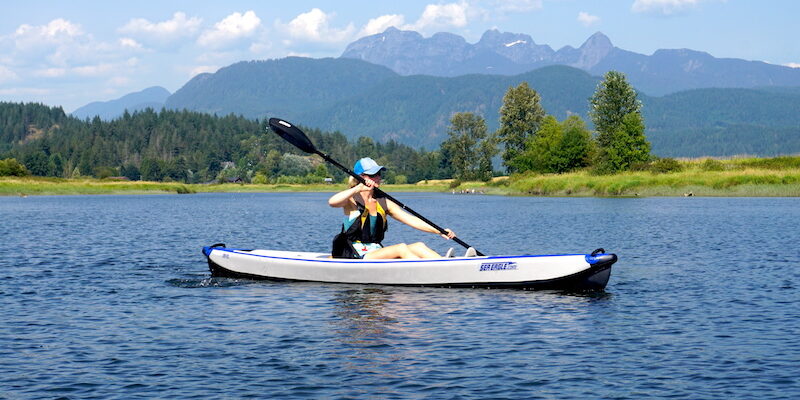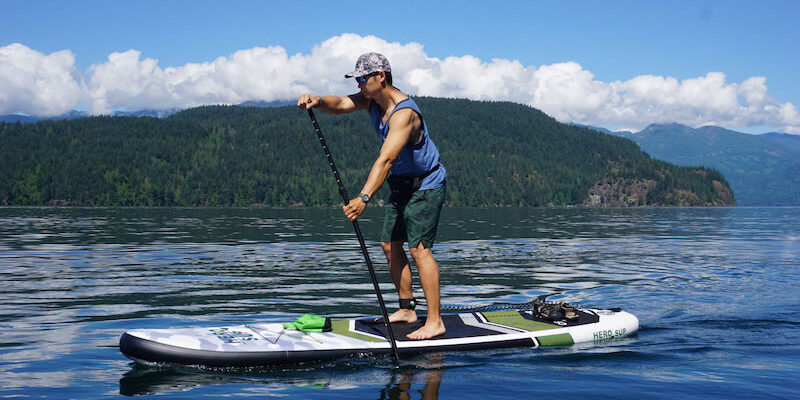If the water isn’t frozen, there’s no reason to stop kayaking when the weather turns cold.
The trick to keeping warm is all in the layering. If your body and extremities are warm and if you follow some safety precautions, you can enjoy many cold winter paddling days.
Head, Hands and Feet
Head
Always wear a hat. The majority of the heat from your body will escape through your head, so keeping your head covered and warm is essential.
Any type of hat will work, whatever is most comfortable for you.
For whitewater kayaking, wear a thin beanie under your helmet. For flat water or sea kayaking, wear some type of synthetic cap.
I always have my fleece tuque with me when paddling in the fall or winter. It’s comfortable and doesn’t itch.
If the weather is particularly freezing you could wear a balaclava so that you can cover your whole head except for your eyes.
You might look a little funny, but you sure will be warm!
Hands
Without proper kayaking gloves, your hands will get cold and numb very quickly… especially if they are getting splashed with water.
Regular knit gloves are not going to do the trick. You need something waterproof so invest in a decent pair of neoprene gloves that offer warmth and dryness for your hands.
Some people do not like the feel of paddling with gloves on. Personally I have never had an issue with it. I actually find them quite comfortable and they provide extra protection from blisters.
There are different types of gloves, some thinner and some thicker. Do a little research before buying the pair that is going to work best for you.
Feet
A good pair of paddling booties will keep your feet warm by trapping a thin layer of water inside and holding it against your skin.
I was very surprised with just how comfortable and warm my paddling booties are.
For extra cold days I add a pair of water socks for added warmth and protection. The combination of the water socks and the paddling booties keep my feet very comfortable and warm.
Layers For Your Body
One of the best things for keeping your body warm for cold weather kayaking is a layered dry suit.
The only problem with a dry suit is that they can be very expensive. I’ve personally never purchased one even though I think they are fantastic. They are just so pricey.
If you are doing some major sea kayaking or expeditions or even winter whitewater kayaking, then a dry suit is probably going to be a must for you.
However for the rest of us recreational paddlers, there is no need to spend a huge amount of money to keep warm.
My basic cold weather kayaking outfit is some moisture wicking fleece-lined long underwear, a pair of waterproof rain pants, a long sleeve moisture wicking performance top, a fleece jacket and a waterproof shell overtop.
For where I live, this outfit works well. For freezing conditions you may need an insulated jacket as well as pants.
Another great option is the wetsuit. The wetsuit which is much more affordable than a drysuit will keep your body heat in and still leave room for you to layer.
It keeps a thin layer of water against your skin and the neoprene of the suit. The water will retain your body heat and keep you warm. It works very well.
With a typical ‘farmer John’ type wetsuit, you can then add warm layers on top.
There are just two big rules to follow when layering for cold weather paddling…
1. Avoid Cotton: Seriously avoid wearing cotton. It will soak up water and make you feel damp and cold. Although I normally love wearing cotton, it is the worst fabric for getting wet while kayaking.
2. Choose 3 Layers: When dressing for winter paddling remember you will need three separate layers… The first layer should wick moisture away, the second layer should provide warmth such as a fleece sweatshirt and the third layer should protect you from the elements such as a waterproof jacket.
Once you’re suited up with the proper cold weather gear, you will be able to enjoy paddling in even the coldest of conditions.


Leave a Reply Cancel reply